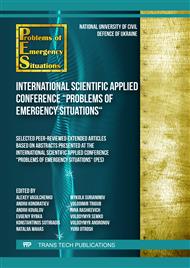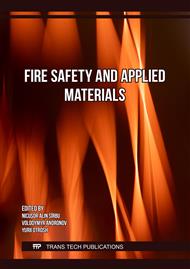[1]
V. Slyusar, M. Protsenko, A. Chernukha, et al., Improving the model of object detection on aerial photographs and video inunmanned aerial systems, Eastern-European Journal of Enterprise Technologies, 1/9 (115) (2022) 24–34.
DOI: 10.15587/1729-4061.2022.252876
Google Scholar
[2]
V. Slyusar, A. Chernukha, O. Petrova, et al., Improving a neural network model for semantic segmentation of images of monitored objects in aerial photographs, Eastern-European Journal of Enterprise Technologies, 6/2 (114) (2021) 86–95.
DOI: 10.15587/1729-4061.2021.248390
Google Scholar
[3]
V. Slyusar, M. Protsenko, A. Chernukha, et al., Construction of an advanced method for recognizing monitored objects by a convolutional neural network using a discrete wavelet transform, Eastern-European Journal of Enterprise Technologies, 4/9 (112) (2021) 65–77.
DOI: 10.15587/1729-4061.2021.238601
Google Scholar
[4]
V. Slyusar, M. Protsenko, A. Chernukha, et al., Improvement of the model of object recognition in aero photographs using deep convolutional neural networks, Eastern-European Journal of Enterprise Technologies, 5/2 (113) (2021) 6–21.
DOI: 10.15587/1729-4061.2021.243094
Google Scholar
[5]
A. Kovalov, R. Purdenko, Yu. Otrosh, V. Tomenko, N. Rashkevich, E. Shcholokov, M. Pidhornyy, N. Zolotova, O. Suprun, Assessment of fire resistance of fireproof reinforced concrete structures, Eastern-European Journal of Enterprise Technologies, 5/1 (119) (2022) 53–61
DOI: 10.15587/1729-4061.2022.266219
Google Scholar
[6]
C.A. Vijan, A. Badanoiu, G. Voicu, A.I. Nicoara, Coatings Based on Phosphate Cements for Fire Protection of Steel Structuresб Materialsю, 14 (2021) 6213.
DOI: 10.3390/ma14206213
Google Scholar
[7]
S.-N. Chen, C. Lin, H.-L. Hsu, et al., Inorganic Flame-Retardant Coatings Based on Magnesium Potassium Phosphate Hydrate, Materials, 15 (2022) 5317.
DOI: 10.3390/ma15155317
Google Scholar
[8]
S. Guzii, Y. Otrosh, O. Guzii, A. Kovalov, K. Sotiriadis ,Determination of the Fire-Retardant Efficiency of Magnesite Thermal Insulating Materials to Protect Metal Structures from Fire, Materials Science Forum, 1038 (2021) 524–530.
DOI: 10.4028/www.scientific.net/msf.1038.524
Google Scholar
[9]
A. Chernukha, A. Teslenko, P. Kovaliov, O. Bezuglov, Mathematical modeling of fire-proof efficiency of coatings based on silicate composition, Materials Science Forum, 1006 (2020) 70–75.
DOI: 10.4028/www.scientific.net/msf.1006.70
Google Scholar
[10]
A. Chernukha, A. Сhernukha, K. Ostapov, T. Kurska, Investigation of the Processes of Formation of a Fire Retardant Coating, Materials Science Forum, 1038 (2021) 480–485.
DOI: 10.4028/www.scientific.net/msf.1038.480
Google Scholar
[11]
A. Chernukha, A. Chernukha, P. Kovalov, A. Savchenko, Thermodynamic study of fire-protective material, Materials Science Forum, 1038 (2021) 486–491.
DOI: 10.4028/www.scientific.net/msf.1038.486
Google Scholar
[12]
L. Jong-Chan, P. Jong-Chul, S. Hun, Effect of external thermal insulation composite system with a non-combustible calcium silicate based mineral on the mitigation for reducing fast spread of flame, J. Korea Inst. Build. Constr, 16, (2016) 397–403.
DOI: 10.5345/jkibc.2016.16.5.397
Google Scholar
[13]
Passive fire protection with calcium silicate materials. Online resource: https://www.promat.com/en/industry/technologies/calcium-silicates/passive-fire-protection/
Google Scholar
[14]
A. Hu, Ch. Du, Y. Hua, et al., Preparation and Flame Retardant Properties of Calcium–Aluminium Hydrotalcite with Root Cutting Silicate Layers as Bamboo Flame Retardants, Materials, 14(23) (2021) 7319.
DOI: 10.3390/ma14237319
Google Scholar
[15]
S. Guzii, T. Kurska, O. Khodakovskyy, A. Kovalchuk, Fire Protection of Steel with Thermal Insulation Granular Plate Material on Geocement-Based, Materials Science Forum, 1038 (2022) 524–530.
DOI: 10.4028/p-a1ae7r
Google Scholar
[16]
V. Petránek, S. Guzii, L. Nevrivova, D. Zezulova, Thermal Insulating Materials for Energy Storage Application, Advanced Materials Research, 911 (2014) 30–35.
DOI: 10.4028/www.scientific.net/amr.911.30
Google Scholar
[17]
V. Petranek, S. Guzii, K. Sotiriadis, L. Nevrivova. Study on the Properties of Geocement Based Thermal Insulating Materials for High Temperature Technical Appliances, Advanced Materials Research, 734–737 (2013) 2356–2359.
DOI: 10.4028/www.scientific.net/amr.734-737.2356
Google Scholar
[18]
P. Krivenko, S. Guzii, L. Bodnarova, et al., Effect of thickness of the intumescent alkali aluminosilicate coating on temperature distribution in reinforced concrete, Journal of Building Engineering, 8 (2016) 14–19.
DOI: 10.1016/j.jobe.2016.09.003
Google Scholar
[19]
J. Sarazin, C. A. Davy, et al., Flame resistance of geopolymer foam coatings for the fire protection of steel, Composites Part B: Engineering, 222 (2021) 109045.
DOI: 10.1016/j.compositesb.2021.109045
Google Scholar
[20]
M.-B. Watolla, G.J.G. Gluth, et al., Intumescent geopolymer-bound coatings for fire protection of steel, Journal of Ceramic Science and Technology, 8(3) (2017) 351–364.
Google Scholar
[21]
N I Kozhukhova, et. al., High temperature effect on structure formation and performance of hybrid geopolymers, J. Phys.: Conf. Ser., 1353 (2019) 012066.
DOI: 10.1088/1742-6596/1353/1/012066
Google Scholar
[22]
S. Guzii, I. Bazhelka, N. Svitlychna, V. Lashchivskiy, Protection of Wood from Burning with Paints on Alkaline Aluminosilicates-Based, Materials Science Forum, 1006 (2020) 19–24.
DOI: 10.4028/www.scientific.net/msf.1006.19
Google Scholar
[23]
M. Sukhanevich, S. Guzii, The effect of technological factors on properties of alkali aluminosilicate systems used for preparation of fireproof coatings, Refractories and Industrial Ceramics, 45 (2004) 217–219.
DOI: 10.1023/b:refr.0000036733.85631.f1
Google Scholar
[24]
P.V. Krivenko, E.K. Pushkarjeva, M.V. Sukhanevich, S.G. Guziy, Fireproof coatings on the basis of alkaline aluminum silicate systems, Ceramic Engineering and Science Proceedings, 29(10) (2009) 129–142.
DOI: 10.1002/9780470456200.ch13
Google Scholar
[25]
K. Sotiriadis, S.Guzii, I. Kumpová, et al., The effect of firing temperature on the composition and microstructure of a geocement-based binder of sodium water-glass, Solid State Phenomena, 267 SSP (2017) 58–62.
DOI: 10.4028/www.scientific.net/ssp.267.58
Google Scholar
[26]
K. Sotiriadis, S. Guzii, P. Mácová, et al., Thermal Behavior of an Intumescent Alkaline Aluminosilicate Composite Material for Fire Protection of Structural Elements, Journal of Materials in Civil Engineering, 31(6) (2019) 04019058.
DOI: 10.1061/(asce)mt.1943-5533.0002702
Google Scholar



